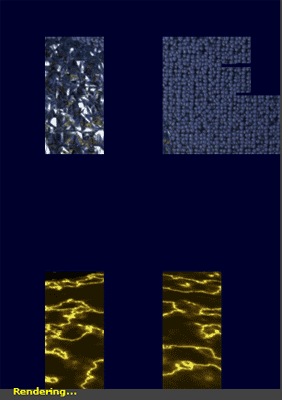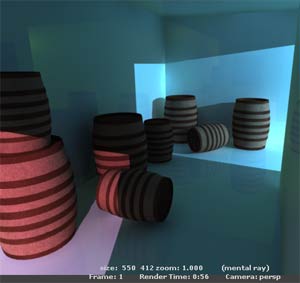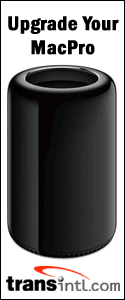
MAIN INDEX of latest speed tests
|
|
Originally posted February 15th, 2005, by rob-ART
morgan, mad scientist We wanted to see how a demanding application like Maya 7 would fair on the awe inspiring Quad-Core G5. Our first Maya sample project was from the now defunct Maya Test Center. It's simply called, "RenderTest." Below is what the completed render should look like. MAYA USES ALL FOUR PROCESSORS Now for the bad news. When I used C.H.U.D. tools to disable two of the four cores, the render speed was the same. Huh? What were those other two cores doing before? GETTING THE GRAPHICS CARD INVOLVED After posting this article, we stumbled across this tidbit on the Maya support site: NOTE: The Quadro FX 4500 has been tested and qualified with CG enabled in Maya 7.0. The use of CG is not on by default and must be turned on using environment variables added to the Maya.env file. This file exists in your HOME/Library/Preferences/Alias/maya/7.0 directory. The environment variables are as follows: When we performed a "production quality" HW render of two sample projects (F5 Fighter and Space Frigate), the render time was over 200% faster when CG was enabled versus disabled. But here's the kicker -- the GeForce 7800 GT proved it does support CG and completed the HW render in identical times to the Quadro FX 4500. FRAME RATES IN ANIMATION COMPARING QUAD-CORE TO OTHERS And we only had a Maya 7 license for the Quad-Core, so we couldn't really do a shootout with the current crop of Macs or PCs. But we had to show you something so here's some results running the same sample projects under Maya 6.5: We're not sure whey the Mental Ray Render was so much faster than on the other two systems above. It was using up to 235% of the available 400% CPU cycles, for what it's worth. Here's the finished product Mental Ray Render (by ZooRender). DO I REALLY NEED A $1650 GRAPHICS CARD FOR MAYA? We believe the other optional card, the $350 GeForce 7800 GT, can do some shattering of its own. After all, NVIDIA says it has "subsurface scattering, high dynamic range lighting, and transparency supersampling." Apple says it's what you need for "faster performance for motion graphics, animation, and 3D design and visualization." I asked Steve Cutchin, Manager of Vizualization Services at the San Diego Supercomputer Center and resident Maya guru, to comment on the Quadro versus GeForce issue. He said, "There is a small set of specific hardware features that the Quadros I asked Steve to explain the use of a uniquely Quadro feature like accelerated clip or overlay planes and how that feature would contribute to an efficient Maya session. He said, "Overlay planes are just like layers in Photoshop. When you click on a drop down menu on a card without overlay planes (support -- like the GeForce), the card has to copy the screen image where the menu will appear to a buffer. After you release the menu it copies the buffer back to where the menu was drawn. This costs memory on the card and the copying time. CONCLUSION As for which graphics card you need, if money is no object, the Quadro FX 4500 certainly does it all. And it's the meanest looking graphics card I've ever seen -- full length, double wide with cooling tubes and all. We just weren't able to prove or disprove its necessity or desirability when using Maya 7. The GeForce 7800 GT does work fine with Maya, based on our experience and the testimony of others. And depending on how you use Maya, it very well may be more than sufficient for the job. So unless you are... READER FEEDBACK OTHER MAYA TESTS WELCOME RELATED ARTICLES Don't miss our other Quad-Core G5 Power Mac page with our new Photoshop CS 2 test as well as After Effects. See also the Core Image and 3D OpenGL tests comparing the three graphics cards available on the Quad-Core G5 Power Mac. WHERE TO ORDER YOUR DUAL-CORE G5 POWER MAC If you live in the USA and plan to purchase an APPLE product, please CLICK THIS LINK or any APPLE DISPLAY AD to help us earn our affiliate commission. It's a great way to support Bare Feats. We found really good deals on PC2-4200 memory for the Dual-Core and Quad-Core is at Other World Computing. They are one of the few companies shipping a 4GB (2GBx2) kit and at a radically low price. Check out their PC2-4200 memory page!
For refurbished, reconditioned, open box (as well as new) G5 Power Macs, check with Small Dog and Power Max. Check also at the Apple SPECIAL DEALS section for factory refurbs and other specials. WHERE TO BUY "OLDER" G5 POWER MACS All other models of G5 Power Mac (AGP) have only 4 memory slots, 33MHz PCI slots, 450W Power Supply, and slower frontside bus speeds. If you can't find the model you want at Apple's Special Deals page, Small Dog's site, or Power Max's site, go to Froogle.com and search on the model number. Has Bare Feats helped you? How about helping Bare Feats?
Is The Quadro FX 4500
Really Necessary?

Our first discovery was how well Maya 7 uses the four processors to do Software Rendering. This was proven not only with Activity Monitor (which shows it using as much as 380% of the available 400%), but by observing the "construction" of the model simultaneously in four different areas of the render window. 
When you use the Hardware Rendering option in the Maya Render Project's sample, part of that rendering is handed off to the graphics card. That includes such functions shadowing, anti-aliasing, reflectivity, and transparency. We compared not only the speed of the render (which was identical) but examined the resulting graphic representation of the model. The results appear exactly the same no matter what graphics card we used.
MAYA_ENABLE_HWR_CG_PROGRAMS = 1
MAYA_HWR_CG_FRAGMENT_PROFILE = arbfp1
Another test that's supposed to lean on the graphics card is the HW render and playback of an animated sequence called "Particles." Again, the render speed was identical and the playback framerate was identical with all three graphics cards.
We were hoping to show you graphs showing the performance difference between the three graphics cards for the Quad-Core, but no matter what test we ran, the results was the same. 


Apple states that the $1650 Quadro FX 4500 "...includes hardware support for anti-aliased points and lines, accelerated clip planes, and two-sided lighting, making it an ideal choice for the most advanced design and visualization applications." NVIDIA says of the FX 4500 that "it shatters the limits of performance,... precision, and quality."
have that the GeForces don't.... In general use you don't notice them being missing.
There is one (other) potential feature of the Quadro that would make it superior to a GeForce. That is in its memory management. The Quadro is advertised as having a special set of code for dealing with large objects that consume most of the memory on the card and for dealing with multiple GL context windows...
Now the above is irrelevant for 'Hardware Rendering' in Maya since you never render (or playback) two different views at the same time.
Where could the difference actually matter? In Maya you often have four different views open... for editing your scene.... If the (model) is large and really hammers on the graphics card (during the editing process), that is where you should expect to notice a difference between the two cards (in terms of performance)."
With overlay planes (support in the Quadro), there are set aside planes for drop down menus (and other things) so it doesn’t have to do this framebuffer copying. On (graphics cards) without overlay planes (support), I’ve noticed some very poor redraws inside of Maya. On my Quadro it never happens."
Alias (now AutoDesk) Maya 7 is a great example of a mature professional application that utilizes multiple hardware resources the host system offers. The Quad-Core G5 is a great platform on which to do your Maya development.
a) doing a model that requires stereo 3D visualization,
b) constantly using special features like accelerated clip planes, or
c) attempting to connect two 30" Cinemas to a single graphics card,
we think you can forego the costly Quadro FX 4500 and opt for the GeForce 7800.
"You should find the most complicated model or scene you can find for Maya and then open it up on both cards and move around in the preview panes and rotate the model, etc., and you should see faster performance with the Quadro." (I'd love to do that if someone would send me a complex model or scene -- preferably one that uses anti-aliased lines, clip planes, and two-sided lighting -- Rob-ART)
We don't see our tests as definitive. They didn't appear to take full advantage of the Quadro FX 4500's superior video memory management or other "hidden charms." If you have a suggestion or a sample project that helps us measure the advantages of the Quadro, we'll gladly give it a try.
Some of you have asked which "older" G5 Power Mac models are most desirable. I recommend getting a model with 8 memory slots, 100/133MHz PCI-X slots, and 600W Power Supply. The table below gives the model number, etc., of these most desirable older G5s.
Model Number
M9031LL/A
M9032LL/A
M9393LL/A
M9455LL/A
M9457LL/A
M9748LL/A
M9749LL/A
© 2006 Rob Art Morgan
"BARE facts on Macintosh speed FEATS"
Email
, the webmaster and mad scientist





